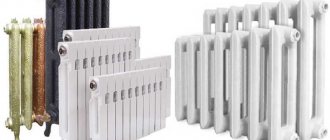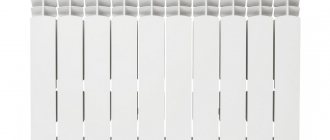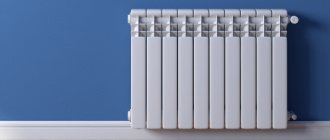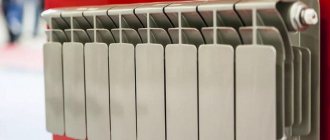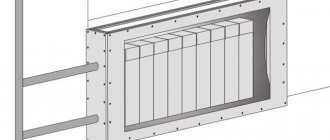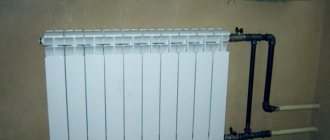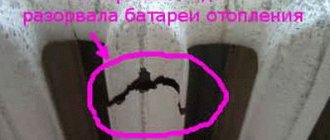Batteries in the interior of an apartment or private house are a necessity. The harsh conditions of our climate require the installation of a high-quality heating system that will ensure comfortable living throughout most of the year. Radiators are difficult to classify as interior decorations. This unsightly part of the communication lines of the heating system spoils many sophisticated interiors. However, radiators can be easily turned into stylish decor with simple manipulations. Let's talk about how to hide batteries in the interior.
The history of radiators
A couple of centuries ago, fireplaces and stoves, which were heated with coal or wood, were responsible for heating the house. In many Russian villages these units are still preserved and are still used for their intended purpose. The first prototype of the heating system is considered to be the Roman hypocausts. They were a set of channels that ran under the floor and connected to the stove. Warming up of the premises occurred due to hot air. Roman baths were heated with water running through copper pipes. The liquid was also heated in the furnace. Thus, in Ancient Rome there were two types of heating systems: steam and water. The ovens themselves were first made of clay, then of stone and brick.
The furnace revolution was carried out by Benjamin Franklin, known largely for his political activities. The inventor used cast iron to make the stove. The metal took a long time to heat up, but also cooled down slowly. The cast iron unit became the prototype of two modern inventions at once: boilers and radiators. The next to show his ingenuity was an English engineer who, based on the Franklin stove, created a complex water heating system for heating a winter garden. The liquid was heated in large volume boilers. The water then entered the pipes, where it circulated, giving off heat, and returned to be reheated. This idea was adopted not only by English engineers, but also by domestic ones.
Similar units were used to heat the Summer Palace in the Peter the Great era. The systems used conventional pipes, which still did not heat the air well due to their small area. The first to come up with a cast iron radiator, which was a system of disks and a pair of thick pipes connected to a boiler, were domestic inventors. Such batteries quickly spread throughout Europe and beyond. However, gravity heating systems eventually replaced units that operated on pumps. In them, the liquid spread along communication lines as a result of forced injection. Closer to the 30s of the last century, tubular radiators came to replace cast iron radiators. After another thirty years, aluminum batteries began to be used. Starting in the 20s, they began to introduce an innovative (at that time) centralized heating system, which is still in use today.
Photos in the interior of the rooms
Kitchen
The kitchen is the ideal room in which all ways to hide batteries will become practical and convenient. If the room is small, then you can hide the radiator with the help of a beautiful tabletop or make a folding table, which will fold out when convenient.
Factories of metal-plastic structures offer a large selection of beautiful large-sized window sills that imitate stone, wood and other materials. A modern window sill does not break under weight, is not afraid of external factors, is easy to care for, wipe clean, is not afraid of scratches, and so on. You can hide any type of battery in this way, including cast iron.
In the photo, wooden boxes are used to disguise the radiators.
Living room
If the radiator is in a niche, then a wide window sill will help create a work area.
You can place souvenirs, vases or potted flowers on the constructed wooden box. You can also cover unsightly radiators in the living room with thick curtains.
The photo shows a modern living room. In order to hide the radiators, a wooden structure was installed, which also serves as a place for rest, storage and decoration.
Bedroom and children's room
In the interior of a bedroom and children's room, batteries can be used as another place to relax, a tabletop for decorative elements or a workplace.
Bathroom
You can hide the pipes in the bathroom using a louvered door, plastic grilles or a cabinet with opening doors.
We hide heating radiators using wooden, glass or plastic screens.
In the photo, the radiators in the bathroom are hidden using a wooden box.
Hallway
For radiators in hallways, glass screens or wooden boxes are suitable. In a small room, covering the battery is only necessary from a practicality point of view. This could be a locker for storing shoes, or the battery will become a small coffee table where keys and other necessary items will be stored.
Types of radiators
Heating radiators are classified according to size, design features and materials of manufacture. When choosing a battery, they are first assessed by its performance, and only then by its appearance. Based on the type of construction, units are divided into three types:
- Sectional;
- Tubular;
- Panel.
In sectional ones, existing sections are removed or new sections are additionally installed. Thus, you can independently regulate the battery power. They are inexpensive, but they heat up quickly. Sectional radiators are difficult to clean. Panel models have a wide range of sizes, which allows you to choose a unit for a specific room. For example, for a small kitchen you can purchase the same compact radiator, which is also easy to hide. However, they are not compatible with high pressure systems. And finally, tubular batteries. The simplest and most popular option. They consist of tubes (as is clear from the name). Usually the segments are located vertically, but there are also models with horizontal placement. The level of heat transfer depends on the diameter of the tubes. Rounded ends prevent dirt from accumulating on the surface. Depending on the location, batteries are classified into:
- Vertical (high);
- Floor-standing;
- Flat.
The most original option is considered vertical. Their height significantly exceeds their width and usually such a unit does not need to be hidden: it is successfully integrated into a loft, high-tech or modern style.
Bimetallic
The radiator consists of an aluminum box and steel tubes hidden underneath it. This is the most common type, which is widely installed in apartment buildings. Bimetallic batteries can be 100% or 50%. In the first case, the tubes are completely made of steel, and in the second - only partially. Such radiators last a long time, and the need for maintenance occurs very rarely. They heat up quickly and are lightweight, allowing you to install them yourself. Compact radiators fit well with modern design.
In order for the unit to work correctly, it is necessary to additionally install an air bleed valve.
Aluminum
Aluminum radiators are made in two ways:
- Extrusion;
- Casting.
In the second case, additional sections can be connected to the battery. Aluminum radiators are lightweight, inexpensive and come in a wide range of colors and sizes. They are easy to integrate into almost any interior. Radiators heat up quickly, but over time, leaks can form in the spaces between sections. In addition, aluminum is a malleable material; units made from it cannot be subjected to strong mechanical stress.
Steel
Steel units heat up very quickly. The equipment market offers models that are installed at an angle, vertically or horizontally. Unfortunately, the material is susceptible to corrosion. The maximum service life is 15 years. The use of batteries of this type for centralized heating is not allowed, since the material quickly deteriorates if left for a long time without water inside. Steel radiators cannot withstand sudden pressure surges. They are especially vulnerable in weld areas. They will have to be replaced more often than cast iron or copper. Painting the surface with “skip” areas can cause metal corrosion.
Copper
Copper radiators are among the most expensive heating equipment on the market. The units are light in weight and have a shiny surface that does not require additional painting. The material is insensitive to water hammer and pressure surges, since the load is distributed evenly. Copper radiators are suitable for both centralized and autonomous heating systems. The units look stylish in combination with Provence, retro and classic. There is no need to hide such beautiful batteries. They can be used as room decoration.
Cast iron
Cast iron radiators are considered an old retro model. They, in fact, have already become obsolete and are rarely used. The radiator is a system of vertical tubes, the surface of which is often decorated with floral patterns. The units are massive and very heavy, which complicates DIY installation. One person cannot handle such equipment, so they will have to be installed by a group. Disguising a battery in the interior is very difficult. Cast iron takes a long time to heat up, which affects the efficiency of the radiator. To create comfortable temperature conditions in the room, you will have to use a large amount of fuel and time. However, cast iron batteries take a long time to cool down. The average service life of the unit is 30 years. The material is almost resistant to corrosion.
Built-in radiators
The design of built-in radiators already involves proper camouflage of the battery into the floor or wall. The unit is securely closed with a mesh panel that allows heat to pass through. All the “internals” of the system are hidden behind this box. Built-in radiators are necessary for heating spacious rooms with “glass” walls (panoramic windows). Floor models in this case are more effective. According to standards, devices are installed near cold walls with windows. Wall-mounted recessed radiators, which are installed “next door”, provide little heat and weakly warm the room. Floor radiators are a mesh “strip” in front of the window, which does not spoil the interior design, but at the same time successfully copes with the task.
The “warm floor” system also belongs to this category. It is usually installed as additional heating in apartments where a comfortable temperature is not maintained in winter or in “vulnerable” rooms (a balcony converted into a living room).
Convectors
Convector heating is the most modern way to maintain the desired temperature in an apartment.
The operating principle of convectors is that these systems use natural circulation of warm air to heat the space.
There are 2 main types of convector:
- Water;
- Electric.
Water convectors allow you to control the microclimate literally in manual mode, which is very convenient. But such systems are quite difficult to install; their installation requires a pipeline with hot water.
Electric models are much simpler in terms of installation; they are considered the most modern and easy to use. All they need is a connection to the mains via an outlet.
Convectors can even be installed on the floor - an ideal solution for those who want to free up space to the maximum and remove all unnecessary (and not entirely unnecessary) items from the interior.
Methods of stylistic decoration
The simplest option for disguising an unsightly radiator that does not fit with the stylistic decision in the design of the room is considered to be a screen. This is most often a ready-made panel with holes that is used to cover the battery. It can be suspended or built into a special box, that is, it can completely hide the radiator. Screens are made of glass, MDF, metal. There are also wooden panels that look like “wicker”. The color of their surface is selected to match the furnishings of the room. Glass is ideal for modern “high-tech” styles. Metal screens are often made with forging elements. Floral motifs will fit in an original way into country or classic style. Radiators can be decorated not only with the help of screens. The simplest, budget-friendly methods include painting. Colored radiators are combined with the shade of curtains, walls, or make the radiator an accent of the interior. Sometimes the unit is covered with strips of wallpaper, thereby completely masking the surface. Black, gray, white radiators are combined with loft, minimalism, high-tech, futurism and avant-garde. Sometimes fabric curtains are used, which are attached to the windowsill. A similar cozy solution in the style of Provence, eclecticism, ethnicity or classic looks appropriate. Using putty, the drawing is given additional volume. Copper radiators are decorated with artificial patina, aging the surface.
In some cases, radiators are skillfully decorated to look like a “fireplace”. On the sides of the battery there are shelves for books and decorations. It’s worth remembering: the deeper the battery is hidden, the more it will affect its performance.
DIY screen
However, you can make a screen for the battery yourself. Materials such as wood, chipboard or plywood are best suited for these purposes. It is advisable to paint these materials in the color of the room. In addition, plexiglass is perfect for these purposes. This material is safe. You can also apply suitable images with paint or decorate it using the decoupage technique.
The easiest way to make a screen is from wood
If you decide to make a panel for the battery yourself, you should remember the need to make holes in it. They are necessary for the passage of warm air from the battery into the room.
The front panel of the screen is made of 16 mm thick boards
It is convenient to use a perforated fiberboard panel as a grille, which can be purchased at any building materials hypermarket
A frame must be installed in front of the battery
The front panel of the screen is secured with self-tapping screws
The result is a very attractive design.
See also: Proper grouting of tiles in the bathroom with your own hands
How to choose the right one
Radiators are selected according to size, design and material. But their number for a specific room will have to be calculated. To get the correct value, you need to take into account the size of the room, the material from which the frames and the building itself are made, the number of external walls and window openings. Based on these data, the thermal power is calculated.
Battery classification
Modern manufacturers offer owners of private houses, apartments and offices a variety of radiator models that differ in shape, material, size and style.
Principles of battery classifications:
- Purpose for specific rooms: hallway, bedroom, nursery, bathroom, kitchen.
- Installation location: under panoramic or regular windows.
- Installation method: baseboard, floor or wall.
- Shape: in the form of panels, benches or partitions, flat and ribbed.
- Size: narrow and tall.
- Material: steel, cast iron, aluminum.
- Style: retro, modern.
The most effective heating method is the use of convector radiators. They can be floor-mounted, wall-mounted or in-floor. Most often they are used in rooms where panoramic windows are installed.
Convectors built into the floor can be well camouflaged thanks to the wide color range of decorative grilles. Products can imitate the structure of natural wood. Convectors are equipped with fans to provide greater power. They are used for heating utility rooms (garages, boiler rooms), where aesthetic and hygienic requirements are lower than in residential ones.
Heating devices also include heated towel rails, which also provide heating. Electric models operate in a closed system. There are also devices operating in the DHW circuit. Both of them can be designer.
Warm "architecture"
A tubular radiator can also be used as one of the key elements of interior architecture. In a spacious living room with “French windows” (almost from floor to ceiling), tubular vertical objects placed symmetrically on both sides of the opening and having the same height would be appropriate.
Tall vertical radiators, the tubes of which are pressed tightly against each other, resemble pilasters with fluted grooves, which gives the interior additional architectural expressiveness. For interiors with panoramic glazing, the ideal option is low and long radiators placed under the entire transparent part of the wall and repeating its configuration.
Often designers use vertical radiators (straight or semicircular) as a light partition that divides the space into zones. There are models of tubular radiators, even cylindrical in shape, specially created for framing columns.
Noble retro
Models of cast iron sectional retro radiators Roca (Spain), Demir Dokum (Turkey), Floreal (Chappe, France), Tiffany (Scirocco, Italy) Bohemia (Viadrus, Slovakia), Bruxells, Gotica, Parisienne, Lille, Lyons, Victorian (UK) and others can rightfully be classified as design radiators.
The rich relief decoration, created by artistic casting, faithfully reproduces the ornaments inherent in historical styles of various eras. This includes majestic Gothic, lush Baroque, frivolous Rococo, restrained classicism, and romantic modernism. Such radiators are installed in the most visible place, because hiding such beauty behind a curtain is simply a sin.
At the same time, cast iron design radiators do an excellent job with their direct responsibilities. The main thing is to choose the right number of sections (according to the size of the room) and check whether the miracle of decoration will withstand the pressure in the heating system of the house.
